|
|
|
Birds of India: Pakistan, Nepal, Bangladesh, Bhutan, Sri Lanka, and the MaldivesRichard Grimmett, Carol Inskipp and Tim Inskipp
Princeton Field Guides
Princeton University Press
1999
"From the snowcapped Himalayas and the Indus valley, to the Ganges delta and the Sri Lankan forests, the Indian subcontinent is home to 13% of the world's species of birds and thousands of birders and ecotourists flock to the area every year. This field guide will be indispensable to those who wish to find and identify the many species of avifauna of the Indian subcontinent and environs. Featuring more than 150 color plates by eminent bird illustrators from Europe and India, it depicts all the known species in the region, ranging from the Himalayan Snowcock in the north to the Sri Lanka Spurfowl in the south. The plates include all relevant identifiable subspecies, as well as ages and sexes. It contains hundreds of range maps and the succinct text on the facing pages covers identification, voice, and distribution. Specially designed for use in the field, it is a compact version of the landmark A Guide to the Birds of India, Pakistan, Nepal, Bangladesh, Bhutan, Sri Lanka, and the Maldives, hailed on its publication as a "stunning book" that "advanced the cause of Indian birding by 20-30 years." With its modest price, small trim size, and sturdy, weather-resistant binding, this field guide is the one volume that every adventurous traveler to the Indian subcontinent must have."
|
Buy from amazon.co.uk 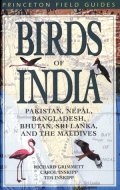
|
|
Pocket Guide to the Birds of the Indian SubcontinentRichard Grimmett, Carol Inskipp and Tim Inskipp
Christopher Helm
1999 (reprint 2001)
"This is a pocket version companion to "Birds of the Indian Subcontinent" covering all the bird species found in India, Pakistian, Sri Lanka, Nepal, Bhutan, Bangladesh and the Maldives. The plates face the descriptions for quick at-a glance reference. This guide provides tables, summarising identification features of particularly difficult groups such as nightjars, warblers and rosefinches."
|
Buy from amazon.co.uk 
|
|
Birdwatchers' Guide to IndiaKrys Kazmierczak and Raj Singh
Prion
1998
"This is an indispensable guide to over 90 sites and areas, for birds as well as other wildlife. It contains a checklist of Indian birds and the first comprehensive checklist of mammals. 'I have been unable to find fault with the areas that I am familiar with and the maps are almost like visiting the site again. It is full of detail on both the major sites and a wealth of smaller sites, all of which are well worth a visit."
|
Buy from amazon.co.uk 
|
|
Birds of the Indian SubcontinentRichard Grimmett, Carol Inskipp and Tim Inskipp
Helm Identification Guides
Christopher Helm
1998
"A definitive guide to the birds of India, with over one thousand three hundred species listed. The text is accompanied by colour illustrations and line drawings, with notes on identification, habits, and distribution maps for each species."
|
Buy from amazon.co.uk 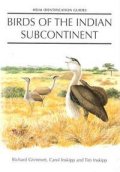
|
|
A Guide to the Birds of India, Pakistan, Nepal, Bangladesh, Bhutan, Sri Lanka, and the MaldivesRichard Grimmett, Carol Inskipp, & Tim Inskipp
With the collaboration of Sarath Kotagama and Shahid Ali
Illustrations: Clive Byers, Daniel Cole, John Cox, Gerald Driessens, Carl D'Silva, Martin Elliott, Kim Franklin, Alan Harris, Peter Hayman, Craig Robson, Jan Wilczur, and Tim Worfolk
Princeton University Press
1998
"Birdwatchers have long waited for a comprehensive and up-to-date identification guide for the Indian subcontinent. This exhaustively researched and beautifully produced book will finally meet that need. Written by three leading experts on the region - Richard Grimmett, Carol Inskipp, and Tim Inskipp - the book provides complete information about the 1,300 species of birds found in India, Pakistan, Nepal, Bangladesh, Bhutan, Sri Lanka, and the Maldives. The guide is firmly rooted in the authors' extensive field experience, reflected in the accuracy and fullness of their bird descriptions. The guide features more than 150 color plates by eminent bird illustrators from Europe and India that depict all the species in the region, ranging from the Himalayan Snowcock in the north to the Sri Lanka Spurfowl in the south. The plates include all relevant identifiable subspecies, as well as ages and sexes. The text consists of a detailed identification section, discussing the differences between similar species and containing descriptions of vocalizations, habits, habitat, breeding, distribution, and status. There are distributional maps for nearly all species. And the authors' introduction provides useful background information about such subjects as conservation, the history of ornithology on the subcontinent, and the climate. A detailed bibliography provides an introduction to the prolific literature on the subcontinent."
|
Buy from amazon.co.uk 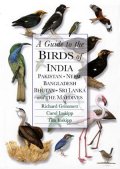
|
|
A Photographic Guide to Birds of the HimalayasBikram Grewal and Otto Pfister
New Holland
1st edition
1998
"This guide provides a comprehensive overview of the wide variety of birdlife to be found in the Himalayan mountains bordering Pakistan, India and Nepal. Over 250 native species are included in the book and each description is supported by a colour photograph taken, where possible, in the bird's natural Himalayan habitat. As well as the common species likely to be encountered, the guide also focuses on some of the rarer, and in some cases highly endangered, species such as the black-necked crane. Thumbnail silhouettes, identifying visually the different family groups, are shown on the species pages of the guide. These aim to lead the reader quickly to the relevant section of the book. In the introduction, information can also be found on the biology and behaviour of the birds."
|
Buy from amazon.co.uk 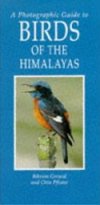
|
|
A Field Guide to the Birds of Southwestern IndiaR.J. Ranjit Daniels
Oxford University Press
1997
"This is an authoritative field guide on the birds of Southwestern India, which will enable bird watchers to identify birds in the region. The guide details a total of 508 species of birds, with descriptions covering size, colour, general shape, unique behaviour (if any), call and habitat. Maps, text figures, black and white and colour plates feature throughout. For easy identification in the field, a brief description of the family precedes each set of related species, and locations are illustrated for ease of reference."
|
Buy from amazon.co.uk 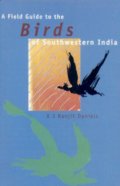
|
|
A Pictorial Guide to Birds of the Indian SubcontinentSalim Ali and S. Dillon Ripley
Illustrations: John Henry Dick
Bombay Natural History Society
Second edition
1996
An edition with revised text.
|
Buy from amazon.co.uk 
|
|
Salim Ali's IndiaEditor: Ashok S. Kothari and B.F. Chhapgar
Oxford University Press
1996
"Presented here, as a tribute to the great ornithologist Salim Ali, are many pictures and lithographs of the 19th-century natural history publications which gave him such immense joy. Also included are selections from the writings of 19th-century naturalists as well as gleanings from the old journals of the Bombay Natural History Society. Some of Salim Ali's own articles along with articles on his beloved Bombay complete the volume."
|
Buy from amazon.co.uk 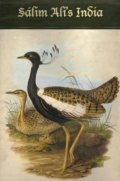
|
|
Goa: The Independent Birders' GuidePeter Harris
1996
A guide to birding sites plus a checklist.
|
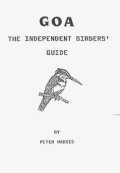 |
|
Birds of Arid and Semi Arid TractsAjit Kumar Mukherjee
Zoological Survey of India
1995
"A consolidated account on birds of the arid and semi-arid areas of northwestern India have been in some demand among naturalists for the past few decades. Birds of such arid areas are not restricted only to the boundries of India but are also spread over, on the basis of physiographic conditions, to countries of Southwest Asia as well. Portions of the two states of northwest India, viz., Rajasthan and Gujarat are drought affected arid areas where desert is well established and the tentacles of aridity have penetrated into contiguous areas of Punjab and Haryana as also of Western Madhya Pradesh. An account of birds inhabiting such arid and semi-arid tracts as found in the aforesaid states, has been prepared to meet the need of the day. This not only enlists birds specially adapted to live under desert conditions but also includes such which have greater flexibility of adaptation to move with seasonally changing physiographic conditions."
|
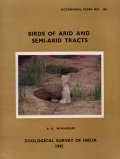 |
|
Ornithology of the Indian Subcontinent 1872-1992: An Annotated BibliographyC. Burg, B. Beehler and S. Dillon Ripley
Smithsonian Institution
1994
|
 |
|
Indian BirdsR.K. Gaur
Brijbasi Printers
1994
A book of photographs of Indian birds.
|
 |
|
Breeding Birds of Kashmir
R.S.P. Bates and E.H.N. Lowther
Oxford University Press
1991
A guide that covers more than 150 species to be found in the Kashmir and adjacent areas.
|
 |
|
What's that Bird?
Kalpavriksh
1991
"This field guide is divided into two parts. The first part looks gives some basics of birdwatching: ground rules of behavior, how to maintain a field diary, what books to refer to, and most important a checklist of features to look out for when observing a bird. The second part concentrates on Delhi, providing a field guide to about 100 of the commonest birds seen in the city. Since most of these birds are also seen in other parts of the country it can be used by birdwatchers elsewhere, especially for areas in and around human settlements. There is also a map to the best birdwatching places in and around Delhi and a 35-page checklist of Delhi's birds, the most comprehensive to date and complete with notes on latest status in a tabular form."
|
 |
|
Checklist of the Birds of Assam
Anwaruddin Choudhury
Sofia Press
1990
Annotated checklist of birds recorded in Assam.
|
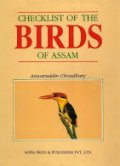 |
|
Bharatpur: Bird ParadiseMartin Ewens
H.F. and G. Witherby
1989
|
Buy from amazon.co.uk 
|
|
Handbook of the Birds of India and PakistanCompact EditionSalim Ali and S. Dillon Ripley
Illustrations: John Henry Dick
Oxford University Press (India)
Second edition
1987
A single, compact edition of the 10 volume Handbook. This second compact edition incorporated more material from the second edition of the full handbook.
|
Buy from amazon.co.uk 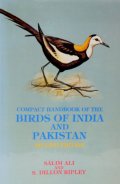
|
|
On the Birds of Poona and VicinityAnil Mahabal and B.S. Lamba
Zoological Survey of India
1987
|
 |
|
A Pictorial Guide to Birds of the Indian SubcontinentSalim Ali and S. Dillon Ripley
Illustrations: John Henry Dick
Bombay Natural History Society
1983
"This unique volume depicts all of the bird species in the Indian subcontinent, systematically organized for easy access and quick reference. The book includes 106 plates, 73 in full color by John Henry Dick, the distinguished illustrator. Concise information concerning status, size, habitat, and distribution of the birds is included. The book also features a "Systematic Index of Families and Species" with notes on the characteristics of each family."
|
Buy from amazon.co.uk 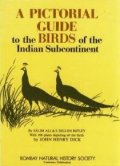
|
|
Handbook of the Birds of India and PakistanCompact EditionSalim Ali and S. Dillon Ripley
Illustrations: John Henry Dick
Oxford University Press (India)
1983
A single, compact edition of the 10 volume Handbook. Includes many colour plates produced for this edition and much reduced text. This compact edition incorpoprated material from the first edition of the full Handbook and early volumes of the second edition.
|
Buy from amazon.co.uk 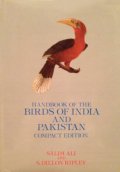
|
|
Results of a Preliminary Survey of Bengal Floricans, Houbaropsis bengalensis in Nepal and India, 1982C. Inskipp
ICBP Study Report No. 2
1983
|
 |
|
Birds of India: Nepal, Pakistan, Bangladesh & Sri LankaMartin Woodcock
Collins
1980
|
Buy from amazon.co.uk 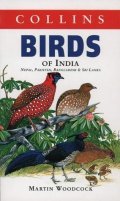
|
|
Checklist of the Birds of MaharashtraH. Abdulali
Bombay Natural History Society
1980
|
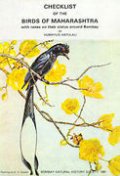 |
|
Field Guide to the Birds of the Eastern HimalayasSalim Ali
Oxford University Press
1978
|
Buy from amazon.co.uk 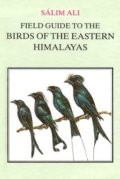
|
|
Birds of Nepal With Reference to Kashmir and SikkimRobert L. Fleming, Sr., Robert L. Fleming, Jr. and Lain Singh Bangdel
1976
|
Buy from amazon.co.uk 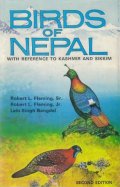
|
|
The Birds Of Kerala
Salim Ali
Oxford University Press
1969
Describes nearly 400 species found in the area with over 100 illustrated in colour plates by D.V. Cowan.
This is a revised and updated version of the work originally published in 1953 as Birds Of Travancore and Cochin.
|
Buy from amazon.co.uk 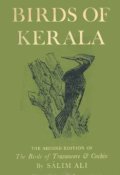
|
|
Common BirdsIndia - the Land and People
Salim Ali & Laeeq Futehally
National Book Trust India
1967
|
Buy from amazon.co.uk 
|
|
The Birds of SikkimSalim Ali
Oxford University Press (India)
1962
Describes over 400 species with 17 colour plates, 9 b/w plates and line drawings.
|
Buy from amazon.co.uk 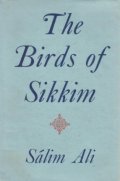
|
|
A Synopsis Of The Birds Of India And Pakistan: Together With Those Of Nepal, Sikkim, Bhutan And CeylonS. Dillon Ripley
Bombay Natural History Society
1961
|
Buy from amazon.co.uk 
|
|
The Birds of Gujurat
Salim Ali
Gujurat Research Society
1956
|
 |
|
The Birds About Delhi
H.W.P. Hutson
Delhi Birdwatching Society
1953
|
 |
|
The Birds Of Travancore and Cochin
Salim Ali
Oxford University Press
1953
With colour plates and line drawings by D.V. Cowan.
Subsequently revised and published in 1969 as Birds Of Kerala.
|
Buy from amazon.co.uk 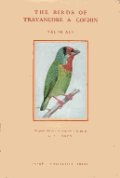
|
|
Breeding Birds of Kashmir
R.S.P. Bates and E.H.N. Lowther
Oxford University Press
1952
|
Buy from amazon.co.uk 
|
|
Indian Hill Birds
Salim Ali
Illustrations: G. M. Henry
Oxford University Press
1949
|
Buy from amazon.co.uk 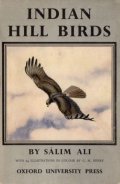
|
|
Popular Handbook Of Indian BirdsHugh Whistler
Revised and enlarged by Norman B. Kinnear
Illustrations: H. Gronvold, Roland Green
Gurney and Jackson
4th edition
1949
From the preface: The Popular Handbook of Indian Birds was first published in 1928, followed by a second edition in 1935, and a third in 1941. This last edition was becoming exhausted when the author died, and Mrs Whistler asked me to prepare this new edition. Mr B. B. Osmaston, who has such a wide knowledge of Indian birds and their habits, has given very great assistance and, in addition, several ornithologists in India, Mr Salim Ali, Mr C. M. Inglis, Mr W. H. Mathews, and the Rev. F. S. Briggs, sent to Mrs Whistler their notes and suggestions which, as far as possible, have been incorporated. In the original edition 250 birds were described, and in each succeeding issue the number was increased. In the present edition 7 more species have been added, and 12 referred to in the text. There is also one new coloured plate and five text figures all of which are the work of Mr Roland Green.
|
 |
|
Popular Handbook Of Indian BirdsHugh Whistler
Illustrations: H. Gronvold
Gurney and Jackson
3rd revised and enlarged edition
1941
From the preface: In the second edition the number of species described at length was increased to 275, and that number has now again been increased to 300. In the second edition, as a new feature, some 430 other species were mentioned in short paragraphs, so that in all over 500 species were brought to the notice of the observer. More of these short paragraphs have been added in this new edition, and in consequence the reader will now find his attention drawn to some 550 Indian birds. It is hoped, therefore, that no really common or striking bird in any part of India, other than those of very local distribution, has failed to find a place in the book. An appropriate number of new illustrations have also been added, and I hold myself fortunate that these were completed just before the lamented death of Mr H. Gronvold, as his plates and figures contributed so materially to the success of the first two editions.
|
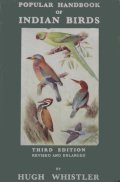 |
|
The Birds of Kutch
Salim Ali
Colour plates: Mrs D.V. Cowen
Oxford University Press
1945
|
Buy from amazon.co.uk 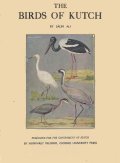
|
|
The Birds of Bombay and Salsette
Salim Ali and H. Abdulali
Prince Of Wales Museum, Bombay
1941
|
 |
|
Popular Handbook Of Indian BirdsHugh Whistler
Illustrations: H. Gronvold
Gurney and Jackson
2nd edition
1935
Covers 275 species.
|
 |
|
Birds Of Dehra Dun And Adjacent HillsB.B. Osmaston
Indian Military Academy
1935
|
 |
|
Birds of an Indian VillageDouglas Dewar
Illustrations: G.A. Levett-Yeats
Oxford University Press
1929
From the introduction: "There is one pleasure which the poorest man may enjoy because it costs nothing, and that is watching the birds that live around him. Some pleasures grow stale after a time; watching birds is not one of these. The more you observe birds the more interesting they become. They cannot tell you about themselves but you can find out a great deal about them by observing them. I hope, by telling you something about the birds in my village, to induce you to watch those in your village, for they will be of the same kind. My village is an ordinary one."
|

 |
|
Popular Handbook Of Indian BirdsHugh Whistler
Illustrations: H. Gronvold
Gurney and Jackson
1st edition
1928
Covers 250 species.
|
 |
|
The Common Birds of IndiaVolume Two: Non-Sporting Birds: Non-Passerine Water and Land BirdsDouglas Dewar
Illustrations: G.A. Levett-Yeats
Thacker Spink & Co
1924?
From the foreword: "When the first volume of this series made its appearance Mr. Dewar mentioned in his preface that if the book was well received, further volumes would be issued. In the event this attempt to produce a popular illustrated account of some of the feathered denizens of India has proved exceedingly popular and the publication of the present volume is the result."
|
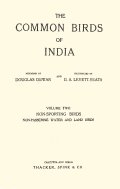
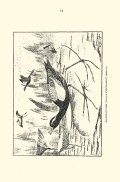 |
|
The Common Birds of IndiaVolume One: The Sportsman's Birds: Wild Fowl, Game Birds and PigeonsDouglas Dewar
Illustrations: G.A. Levett-Yeats
Thacker Spink & Co
1923
From the preface: "Although India can boast of the finest avifauna in the world, no profusely illustrated book exists that deals with the birds of India as a whole. The reason of this is that the birds to be described are very numerous, while the human beings who take an interest in them are comparatively few. The expense of producing such a book would be great and the producers' income from the sale small. Of late years, however, the number of people interested in birds has greatly increased. In view of this fact, the present work has been published. It deals with the birds in which the sportsman is most interested, together with the doves, which cannot well be separated from the pigeons. It is hoped that this volume will be the first of a series describing the common birds of India."
|
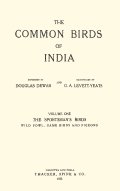
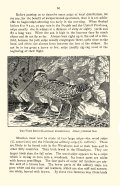 |
|
Himalayan And Kashmiri Birds, Being A Key To The Birds Commonly Seen In Summer In The Himalayas & KashmirDouglas Dewar
John Lane The Bodley Head
1923
From the preface: "The object of this book is to enable people interested in birds to identify those they meet with while walking in the hill stations of the Himalayas and Kashmir and those they see in the Kashmir valley. The birds dealt with are the ones commonly seen in summer at such places. As nine out of ten species of hill birds move to lower levels in winter, the bird population of a hill station in winter differs from that in summer. Had the scope of this book included birds seen in winter at the various hill stations, and those found in summer only at lower elevations than 5000 feet above the sea-level or higher altitudes than 7500, its bulk would have been considerably increased. It would have attained even greater dimensions had I noticed the rare birds that are sometimes seen in hill stations in summer. Paradoxical though it may sound, the value of this book lies largely in its omissions."
|
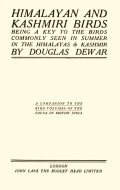
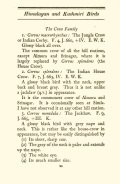 |
|
How to know The Indian WadersF. Finn
Thacker, Spink & Co.
2nd edition
1920
|
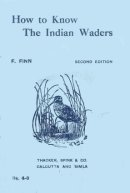 |
|
The Game-Birds Of India, Burma And CeylonE.C. Stuart Baker
Volume 1 illustrations: H. Grönvold, G. E. Lodge, and J. G. Keulemans
Volume 2 illustrations: H. Grönvold
Bombay Natural History Society
1921
Volume 1: Ducks and their allies
Volume 2: Snipe, Bustards, Sand-grouse
Volume 3: Pheasants and bustard-quail
From the introduction: "In 1896 and the following years I wrote a series of articles on " Indian Ducks and their Allies " in the Journal of the Bombay Natural History Society. In 1908 these articles were brought up to date, corrected and added to and appeared in book form, and so well was this volume received by the public, especially by sportsmen in India, that the edition was soon exhausted. The first edition appeared principally to meet a want which had long been felt by Small-Game shooters in India. that is to say a volume, reference to which would not only show how each duck could be identified, but would also give some idea of its habits and its scarcity or the reverse. Hume and Marshall's " Game Birds of India," which was published in 1879-80, grand book as it was and is, was felt to be behind the times, and much had since been recorded in various magazines and journals. But these records were scattered here, there and everywhere, and could not be consulted without the greatest difficulty, and it was, indeed, quite impossible for anyone who had not access to a very complete library to say what had, and what had not, been recorded. The first edition may be said not only to have served its purpose for the time being, but it served yet another and perhaps even more important one, for since its appearance a very large amount of information has been published to add to and correct its contents. This second edition incorporates these additions and corrections, and adds a considerable amount of matter not obtainable by me when writing in India. Several species have been added to the Indian list, and the geographical distribution of certain others has been more correctly given."
|
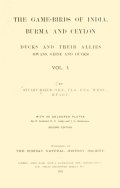
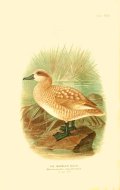
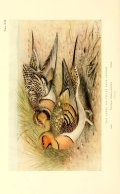 |
|
A Bird Calendar For Northern IndiaDouglas Dewar
W. Thacker & Co / Thacker, Spink & Co
1916
From the preface: "I am indebted to the editor of The Pioneer for permission to republish the sketches that form this calendar, and to Mr. A. J. Currie for placing at my disposal his unpublished notes on the birds of the Punjab. Full descriptions of all the Indian birds of which the doings are chronicled in this calendar are to be found in the four volumes of the Fauna of British India devoted to birds; popular descriptions of the majority are given in my Indian Birds."
|
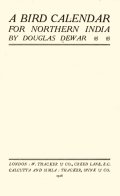
 |
|
Indian Pigeons and DovesE.C. Stuart Baker
Illustrations: H. Grönvold and G. E. Lodge
Witherby & Co
1913
From the preface: "My reasons for writing a volume upon our Indian Pigeons and Dovea are several, and I trust will be deemed sufficient by my readers. In the first place, there has as yet been no book published which deals with these most beautiful birds from the point of view of the Sportsman and Field-Naturalist as well as from that of the Scientific or Museum-Naturalist, and as this is a gap in the records of our Indian Avifauna which badly needs filling, I may be forgiven for trying to bridge it. Skins - as skins - are, without doubt, full of interest, and especially so, perhaps, when the person studying them is more or less intimate with the life-histories of the birds themselves ; but Pigeons are well worthy of study in ways other than by dry skins. To the Field-Naturalist they are birds full of interest; to the Aviculturist they are birds more charming and worthy of culture than has hitherto been generally admitted, and to the Sportsman they offer an object well worthy of attention, for he must have a quick eye, a sure hand, and considerable perseverance and patience before he has mastered their habits and is able to find them and, when found, bring them to bag.
|
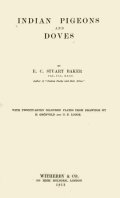
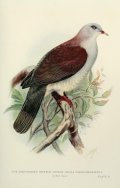 |
|
Glimpses Of Indian BirdsDouglas Dewar
John Lane The Bodley Head
1913
From the preface: "In the brief sketches that follow I find occasion repeatedly to attack the prevalent theories of protective colouration, because it is impossible for the naturalist who uses his eyes to accept these theories. Most of these hypotheses were advanced by field naturalists, but they have since been elaborated by cabinet zoologists and have become a creed. Now, Huxley remarked with truth, 'Science commits suicide when it adopts a creed.' With equal truth he asserted, 'Authorities, disciples, and schools are the curse of science and do more to interfere with the work of the scientific spirit than all its enemies.' In England zoology is at present in the hands of 'schools' and 'authorities' of the kind to which Huxley objected."
|
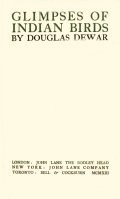
 |
|
Indian Birds; Being A Key To The Common Birds Of The Plains Of IndiaDouglas Dewar
John Lane The Bodley Head
1910
From the preface: "The object of this book is to enable people interested in our Indian birds to identify at sight those they are likely to meet with in their compounds and during their excursions into the jungle. There are several good systematic works on Indian ornithology, but the descriptions in these presuppose that the reader has the specimen in his hand and is able to examine it leisurely, feather by feather. To do this it is necessary to kill the bird in question - a procedure which causes pain to many and gives pleasure to very few. Moreover, unless the seeker after knowledge has some notion as to the order to which the bird he has shot belongs, he will find that seeking it out in the four bird volumes of the Fauna of British India series is a task almost as hopeless as that of looking for the proverbial needle in a haystack."
|
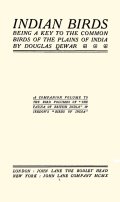
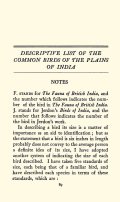 |
|
Birds Of The PlainsDouglas Dewar
John Lane The Bodley Head
1909
Introduction: "It is easy enough to write a book. The difficulty is to sell the production when it is finished. That, however, is not the author's business. Nevertheless, the labours of the writer are not over when he has completed the last paragraph of his book. He has, then, in most cases, to find a title for it. This, I maintain, should be a matter of little difficulty. I regard a title as a mere distinguishing mark, a brand, a label, a something by which the book may be called when spoken of nothing more. According to this view, the value of a title lies, not in its appropriateness to the subject-matter, but in its distinctiveness."
|
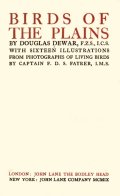
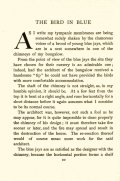 |
|
The Indian Ducks And Their AlliesE.C. Stuart Baker
Illustrations: H. Grönvold, G. E. Lodge, and J. G. Keulemans
Bombay Natural History Society
1908
Introduction: "In 1896 the Honorary Secretary of the Bombay Natural History Society induced me to write a series of articles on our Indian Chenomorphe, and consequently the articles which commenced in Volume xi. of the ' Journal ' of that Society made their appearance. Since the publication of Hume and Marshall's ' Game- Birds,' no attempt has been made to collect the various notes which have from time to time been printed in the 'Asian,' 'The Indian Field,' and other sporting papers, as well as in the B. N. H. S. Journal itself, and it has been a matter of great difficulty—often an impossibility—for either sportsman or ornithologist to know what has already been recorded and what has not. Hence many interesting facts and finds were never recorded at all, and these articles were originally written as much with a view to elicit more information as to place on record in a compact form what had already been recorded. That the raison d'etre was a good one was shown by the immediate receipt by the Editors of the 'Journal ' of numerous notes, giving both information that was new and correcting part that was old. The present book aims at being a corrected, up-to-date edition of these papers, and incorporates, as far as possible, the additional information received since they were brought out."
|
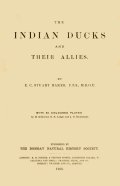
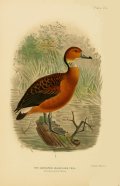 |
|
The Indian Crow, His BookDouglas Dewar
Higginbotham & Co
1906
From the preface: "I offer no apology for producing this book. Far from it. I apologise for the previous neglect of the splendid bird by those naturalists who have already served their time in the Gorgeous East. Is it fitting, nay, is it decent, that the Crow who forms part and parcel of human existence in the Land of Regrets, should have no book he can call his own, no scroll upon which his doughty deeds are writ large? Horses - noble creatures, dogs - dear things, cats - obnoxious quadrupeds, pigeons - self- satisfied birds, fowls - estimable beings, and even whales - unwieldly monsters, have books devoted exclusively to them. Much more then should the Indian crow have his book. - Q.E.D. Lovers of the crow will doubtless read and cherish this booklet. Those who love not the 'treble-dated' bird will find in this brochure a most convenient missile to hurl at the offending bird."
|
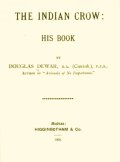

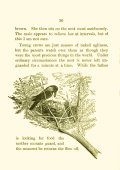 |
|
Bombay Ducks; An Account Of Some Of The Every-Day Birds And Beasts Found In A Naturalist's EldoradoDouglas Dewar
John Lane The Bodley Head
1906
From the preface: "Some apology is perhaps necessary for the title of this book, since the 'Ducks' herein dealt with belong not to the quack-quack tribe. 'Bombay Ducks' is a time-honoured Anglo-Indian expression. In the palmy days of the East India Company, when the now-barren pagoda-tree showered its fruits upon all who shook it, the European residents of the Western Presidency were known as Bombay Ducks to distinguish them from Bengal Qui-his and Madras Mulls. In very early times 'Ducks' was spelt 'Duckys' and is probably a corruption of the Latin duces - leaders or bosses. Dwellers in Bombay are no longer called ducks, nevertheless the expression Bombay Ducks or Bombay Duck still survives. It now denotes (I know not why) brittle pieces of sun-dried fish which are eaten with curry in South India. It seems to me that the animals dealt with in this volume, all of which are to be found on the 'Bombay side,' have at least an equal right with pieces of dried fish to be called 'Bombay Ducks'."
|


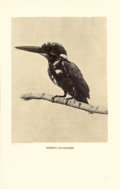 |
|
How to know The Indian WadersF. Finn
Thacker, Spink & Co.
1906
Opening line: Leaving out of consideration the kites and crows, and few other very conspicuous birds, the waders may be said to be the most striking items in the bird population of India. One or other of them may be met with anywhere, for all do not affect the neighbourhood of
water.
|
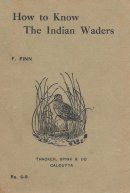 |
|
The Birds Of CalcuttaFrank Finn
Thacker, Spink & Co.
2nd edition
1904
Preface: The kind reception accorded to the first edition of the present little work has been deemed a justification for its reproduction in an improved form. A few necessary alterations have been made to bring it up to date, and the chapters have been re-arranged so as to bring the birds dealt with into the same order as that in which they occur in the Fauna of British India, Bird volumes. The scientific names used for Indian birds are those of the above work, the few foreign species mentioned bearing the name given them in the British Museum, Catalogue of Birds. The usefulness of the book will, it is hoped, be enhanced by the illustrations, which have been drawn by that well-known ornithological artist, Mr. Herbert Good- child, in most cases from living birds in the collection of the London Zoological Society.
|
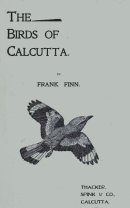
 |
|
The Birds Of CalcuttaFrank Finn
1901
|
 |
|
The Common Birds of BombayEha
Thacker & Co / Thacker, Spink & Co / Higginbotham & Co
1900
Eha is the penname of Edward Hamilton Aitken.
From the introduction: "During the last year or two I have been repeatedly pressed to write a simple account of the Birds of Bombay. It has been represented to me that there are many who would like to know the common birds that appear in their gardens and about their houses, to learn their names and something of their natures, without "collecting" them, and that there is no book from which such persons can get much help. I confess that scarcely any argument could appeal more strongly to my nature than this. For I think that the study of natural history fails of its finest fruit if it does not lead us to regard living creatures generally with a kindly and sympathetic interest which tends to make all needless sacrifice of their lives more and more repugnant to our feelings. The first steps may have to be taken through blood, and I must own that in my boyhood I was murderous in heart, but not in hand, for I had no gun, only a catapult ; and for this I am thankful. I seldom killed anything, while the hours I spent in stalking my game and watching for a chance of getting a fair shot taught me more about the personal habits of birds than I could have learned in any other way."
|
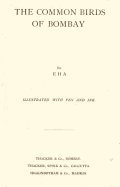
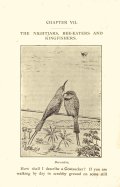
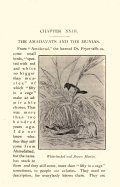 |
|